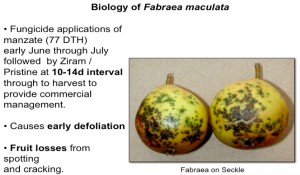
In larger trees the challenge has always been coverage, especially in tops of the tree. We have seen orchards this year with overwhelming populations, even after timely applications and use of higher volume. Some of the issue with loss of control may be related to wind speed from the airblast fan as droplets move quickly past the leaf and into the drive row. Slowing fan speed so that the spray moves just beyond mid line of the tree would get the material where its most needed. Suckering trees in mid-late June, when suckers can be pulled in dry weather to avoid fireblight, often dramatically reduces psylla populations as psylla prefer to lay eggs and develop on young growing leaf tissue. Sucker removal will also improve spray penetration and coverage.
We’ve had substantial rainfall over the past week to help in washing off young nymphs. Rains have also spread fabraea in orchards thta have less then stellar control of the disease. Yet the use of summer applications to manage overlapping pear psylla generations will be essential as drier conditions move into the region. The use of Delegate WG in single or multiple applications to manage the obliquebanded leafroller (used with 0.25% horticultural oil) should have reduced the number of nymphs in late June and early July. As a follow-up, the neonicotinoid, Actara (Thiamethoxam), will also provide control of emerging adults and subsequent nymph populations. Remember that the pyrethroid group will be less effective as temperatures exceed 70F. Generally these insecticides as a group have not provided effective control of psylla for quite some time in orchards which frequent their use.
Insecticide resistance has resulted in lower levels of pear psylla insecticide susceptibility, reducing effectiveness of current pest management strategies. Recent studies conducted at Cornell University’s Hudson Valley Laboratory have demonstrated excellent control of the pear psylla using two unique OMRI products. The kaolin clay product Surround WP (anhydrous aluminum silicate) and highly refined horticultural oils (HRO’s) used successfully in pre-bloom and season long insect management programs to maintain psylla populations below economic thresholds.
Furthermore, applications of HRO’s were observed suppressing the impact of Fabraea leaf spotting and subsequent reduction in defoliation in plots treated with horticultural oil compared to untreated trees.
A resent study outlining the use of horticultural oil for summer management of pears is outlined here, with audio embedded PowerPoint presentation here.
The study was conducted in a commercial Hudson Valley pear orchard in Milton, NY demonstrating the commercial use of these two OMRI products as pest management tools for pear psylla management to achieve commercial levels of control. Additional variables of air induction nozzles compared to commercial hollow disk nozzles in airblast applications were used to study the effects of off target drift; sprayer speed and volume were employed across field plot treatments.
The need for season long management of Fabraea using applications of fungicides at ten day to two-week intervals reduce the additional application costs of bi-weekly HMO applications for post bloom pear psylla management through the incorporation of horticultural oils to the fungicide program.


